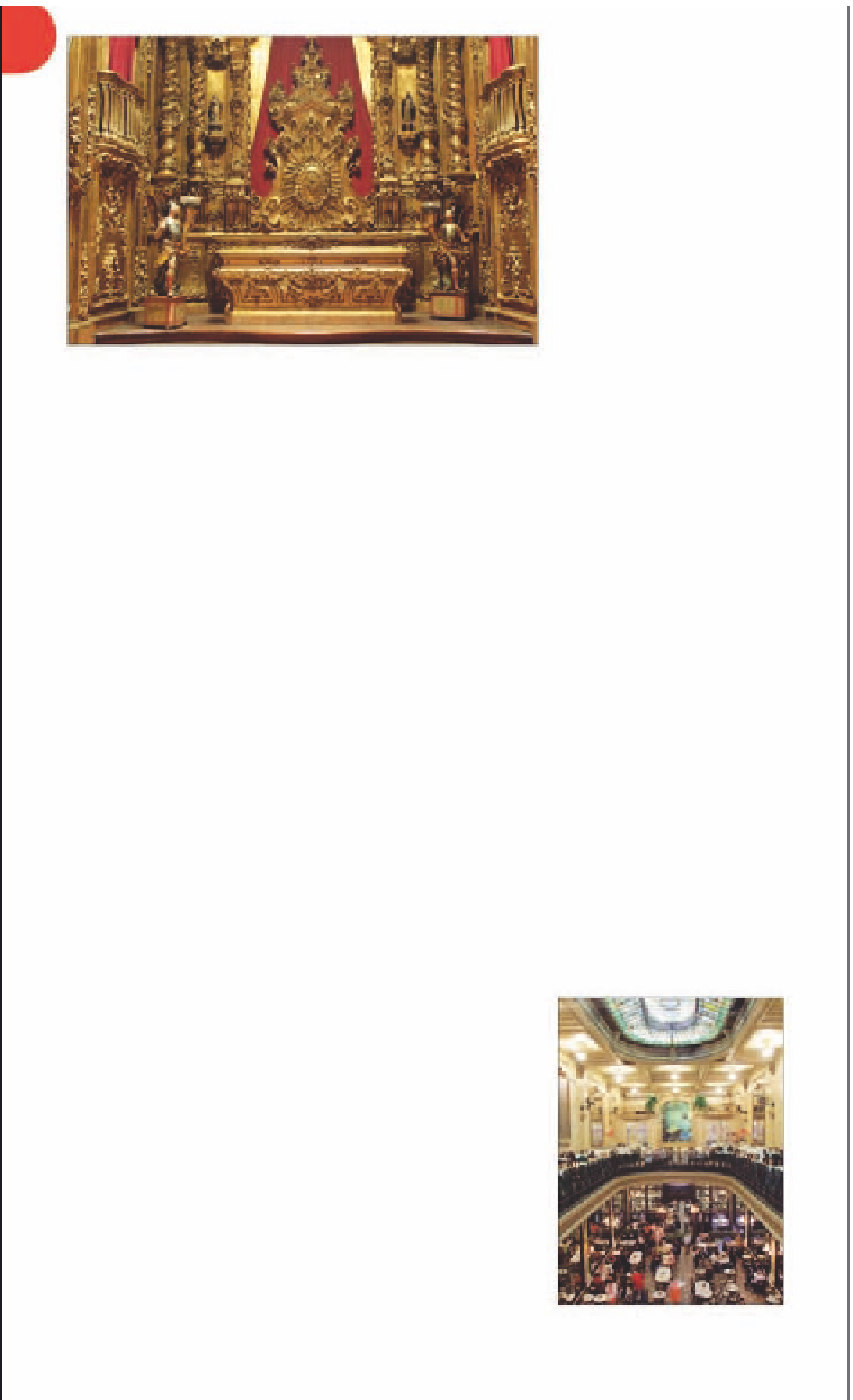Travel Reference
In-Depth Information
Baroque art in Brazil. Built
between 1657 and 1772, the
church exhibits various works
of the Portuguese artist
Francisco Xavier de Brito.
His art heavily influenced
the Brazilian artist Aleijadinho
(see p131)
, whose own work
spectacularly adorns many
of the Baroque churches of
Minas Gerais. One of the
church's highlights is the
1738 painting of the glorifi-
cation of St. Francis by
Caetano da Costa Coelho,
the first Brazilian painting to
be done in perspective.
The neighboring Convento
de Santo Antônio, dating back
to 1615, is one of Rio's oldest
structures. Its Baroque
interiors contain priceless
colonial art and
azulejos
(Portuguese tiles).
Detail of the gilded Baroque interior of Mosteiro de São Bento
Mosteiro de
São Bento
2
Rua Dom Gerardo 68 (entrance
by elevator at No. 40), Centro.
Map
5 D2
.
Tel
(021) 2206 8100.
q
Visitors should remember to
dress appropriately if they
wish to view the interior of
the monastery.
Docks & Avenida
Rio Branco
3
Praça Mauá, Centro.
Map
5 D2.
q
São Bento.
#
7am-6pm
Confeitaria
Colombo
5
Rua Goçalves Dias 32, Centro.
Map
5 D5.
Tel
(021) 2505 1500.
q
daily.
7:15am Mon-Sat;
8am, 10am & 6pm Sun.
www
.osb.org.br
8
7
5
Carioca.
7
Benedictine monks from
Bahia founded the São Bento
Monastery in 1590 and much
of the historic building, loc-
ated on the hills of São Bento,
has remained structurally
untouched since it was built
between 1617 and 1641. The
exterior of the main building
reflects the simplicity of the
time of its construction and
gives no hint of the opulence
of the gilded Baroque interior.
A number of the works
on display were carved
by one of the monks, Frei
Domingos da Conceição
(1643-1718). They include
the main altar of the mon-
astery's church. The painting
displayed on it, which was
created around 1676, is
dedicated to Nossa Senhora
de Montserrat (Black Virgin).
São Bento is still very
much a working monastery.
The Benedictine monks are
protective of the monastery
and their work and have
tried hard to keep the church
from becoming simply a
tourist attraction. Many areas,
such as the beautiful cloisters,
remain out-of-bounds except
on special occasions. Mass
for the public is said daily,
with a full Gregorian chant
at 10am on Sundays.
Though not as thriving as
they once were, Rio's docks
remain one of the most
important in South America.
The terminal in the old
Touring Club do Brasil in
Praça Mauá is the first port of
call for visitors who arrive in
Rio by ship. The docks are
situated at the top end of
Avenida Rio Branco, one of
Brazil's important business
streets. The street dates from
1904, when 590 buildings
were demolished to make
way for a modern central
avenue, the spine of Rio's
financial district. A handful of
early 20th-century buildings
survive, among them the
glorious Theatro Municipal.
9:30am-8pm
Mon-Fri, 9am-5pm Sat.
Carioca.
#
limited.
www
.confeitariacolombo.com.br
7
The Colombo Tearoom dates
from 1894 and remains a
wonderful mix of Art Nouveau
and Belle Époque. Located in
what was then the very heart
of Rio, it was a meeting point
for intellectuals, artists, and
politicians. Regulars included
politician Ruy Barbosa,
President Getúlio Vargas, and
composer Heitor Villa-Lobos.
The mirrors were shipped
in from Belgium and the
marble from Italy, while
Igreja de São
Francisco da
Penitência
4
Largo de Carioca 5, Centro.
Map
5 D4
.
q
Carioca.
Tel
(021)
2262 0197.
#
9am-noon, 1-4pm
Tue-Fri.
&
8
Restored to its former glory,
the church of São Francisco
da Penitência is considered
one of the richest and most
beautiful examples of
Lavish interior of the historic
Confeitaria Colombo
For hotels and restaurants in this region see pp366-9 and pp394-6







































